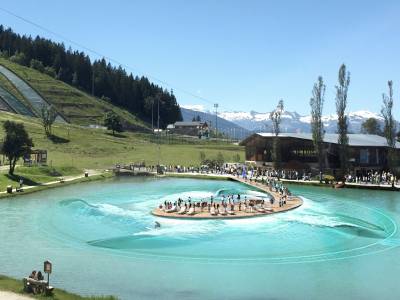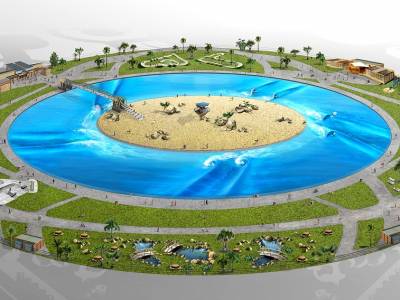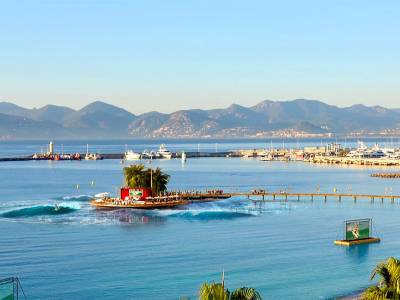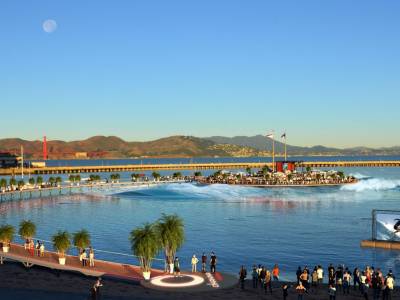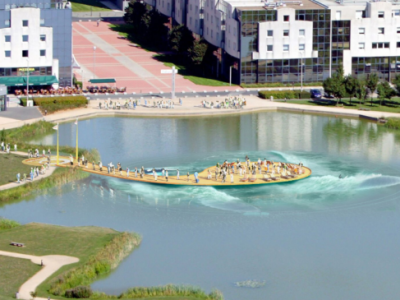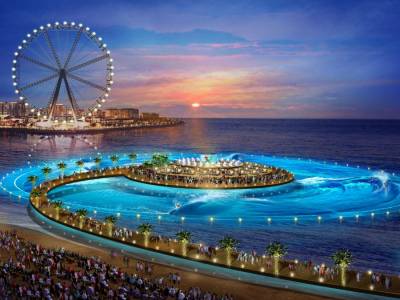Okahina
Okahina Wave Technology
The Okahina Wave technology from Laurent Héquily and his company, Wavering Solution, is a new look at the circular wave pool strategy. The wave generation mechanism consists of a floating atoll surrounded by a ring. A few wave generators, a.k.a. foils, revolve around the ring and generate waves that propagate toward the center of the atoll where they encounter shallow water and break. The “reef" on which the waves break is spiral-shaped to help reduce the circular current that would quickly build up after running the wave generator for any length of time.
The entire structure is tethered to the floor of the body of water.
Okahina Wave technology was patented in 2015 and tested by Laurent at a secret prototype installation in New Aquitaine. That prototype was 24m in diameter and produced waves measuring more than 1m high on the face of the wave. The waves it created were surfable for up to 14 seconds.
Early generations of Webber Wave Pool technology (pictured below on the right) also generated waves that propagated inward from an outer ring, but the eco-friendly and cost-conscious design of Okahina has financial and environmental advantages. The unique characteristics of the Okahina Wave technology also earned Laurent Héquily a patent on the technology in 2015.
The system can be placed in any body large body of water. Its engineered at the Okahina factory in Bordeaux and then shipped to the site where to be installed. Because it prebuilt, for the most part, and it doesn’t require installation of a giant pool or water filtration systems, construction costs are relatively low and the permitting process is potentially less arduous. According to the Okahina Wave team, on-site installation takes only a couple weeks. It’s also relatively easy to remove the system from the water and return the installation site to it natural state in less than 1 month.
In terms of size, the installation Futuroscope will be 36m in diameter and the installation at Libourne will be 60m, if everything goes according to plan.
The wave action generated by Okahina Wave technology also benefits aquatic life by oxygenating the water. Installation in the ocean are expected to attract sea life including mollusks, fish and anything else that feeds on smaller prey that hangs out on reefs. The design includes a natural barrier to keep jellyfish and sharks out of the surfing area.
Wave Size and Shape
As the waves propagate from the outer ring toward the center of the atoll, the move from deeper to shallower water where they stand up, crest, and break.
Okahina Wave is predicting that the waves will measure between .6 and 2m (2-6 feet) high on the face of the wave, depending on the size of the installation and the operator’s settings. The shape of the wave can be “hollow and tubing" according to some company statements but they also state that it will be “for surfers of all levels".
The length of ride depends on the size of the installation. In their larger installations, Okahina claims each surfer will get up to a 30 second ride. In smaller installations, like the one at Futuroscope, the length of ride will be around 12 seconds.
The foils can run in either direction allowing an installation to produce left or right-hand waves.
Read More
Capacity and Productivity
Capacity and productivity of Okahina Wave technology is a closely guarded secret.
According to Laurent Héquily, the artist renditions and capacity reports from other surf new publications are inaccurate.
However, it is clear that there are a number of foils producing wave simultaneously when the wave generator is running. According to Laurent, the foils run circles around the atoll continuously until they have to stop for settling or change of direction.
Okahina has reported that surfers will be able to ride each wave for 30 seconds and a wave will be generated every 15 seconds in its larger pools. In this scenario, a foil passes a take-off point every 15 seconds where a surfer starts a new ride. Then, 30 seconds later, that surfer exits the wave leaving it open for the next surfer waiting a the take-off point.
The number of foils, which will grow with the diameter of the atoll, will have a significant impact on the productivity. It’s not clear how many foils will be used in a standard installation, but in smaller installations like the 36m Futuroscope, they plan on using 3 foils. In that case, a foil will pass the take-off point every 10 seconds where a surfer will start a new ride. The duration of the ride at Futuroscope is about 12 seconds, at which point the surfer exits the wave leaving it open for the next surfer waiting at the take-off point.
In terms of capacity, its not clear how many surfers will share each 1-hour session, but Surfer Today reported that a Okahina Wave installation can handle 50 surfers at a time. That report was identified as “inaccurate" by Hequily.
Settling time is a critical factor for all wave pools. Settling time could be particularly challenging for the Okahina team. Pushing energy in the same circular pattern can quickly generate current which deteriorates the quality of the waves. To help address this, the Okahina team is planning to shape the “reef" in a spiral fashion that will help minimize the current generated from the spinning foils.
Controlling Okahina Wave Pools
Okahina has yet to shared information about how their wave generation technology is controlled.
Based on other circular wave pools and foil systems, speculators suggest that operators will be able to control the speed and angle of the foils which will translate to changes in the size and shape of the wave.
It’s not clear whether they will be able to make these changes during a 30 second ride, between rides or between sessions. It’s also not clear whether or not the four foils must produce the same size/shape wave or if they can be controlled independently.
The Pool
The beauty of the Okahina Wave is that it can be installed into existing bodies of salt or fresh water. The planned side for the first two installations of Okahina Wave technology (Futuroscope and Libourne) will be 36m and 60m in diameter, respectively. Assuming the technology will benefit from water around the outside of the ring (e.g. to reduce settling time), its probably a safe bet that the lagoon needs to be roughly 2x the diameter of the installation.
The minimum depth of the water is not clear.
Energy Consumption
The exact figures on energy consumption have not been released by the Okahina Wave team, but they have made the claim that its less than other wave pools on the market. Franceinfo.fr reports that a 1.2 meter wave requires about 35kw to generate (roughly the power required to run an electric car).
Wave Pools Powered by Okahina Wave Technology
Highlights and Lowlights
| Installable into existing bodies of water. | |
| Quick installation in a matter of weeks and easy removal. | |
| Potentially endless rides. |
| Unproven. |

